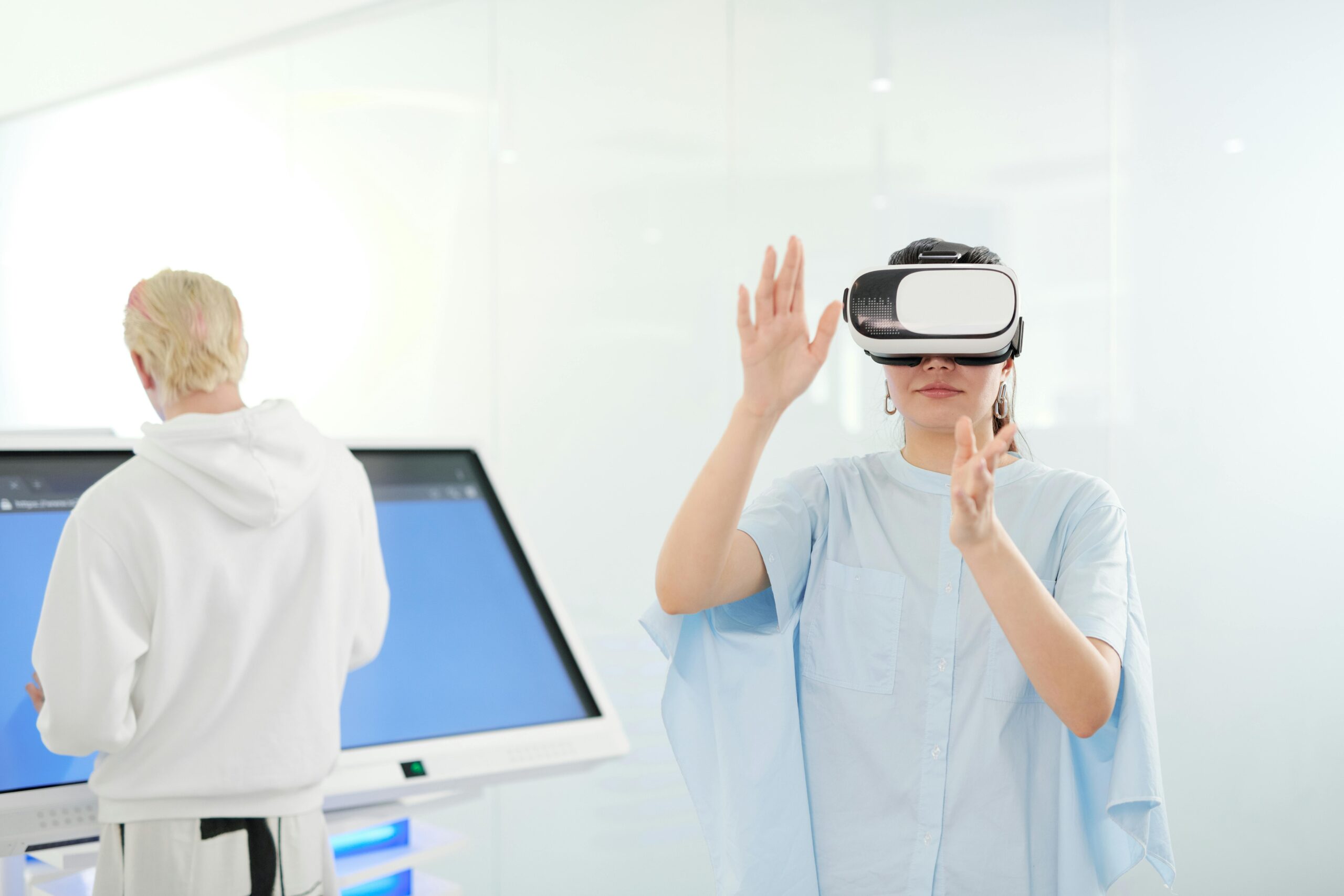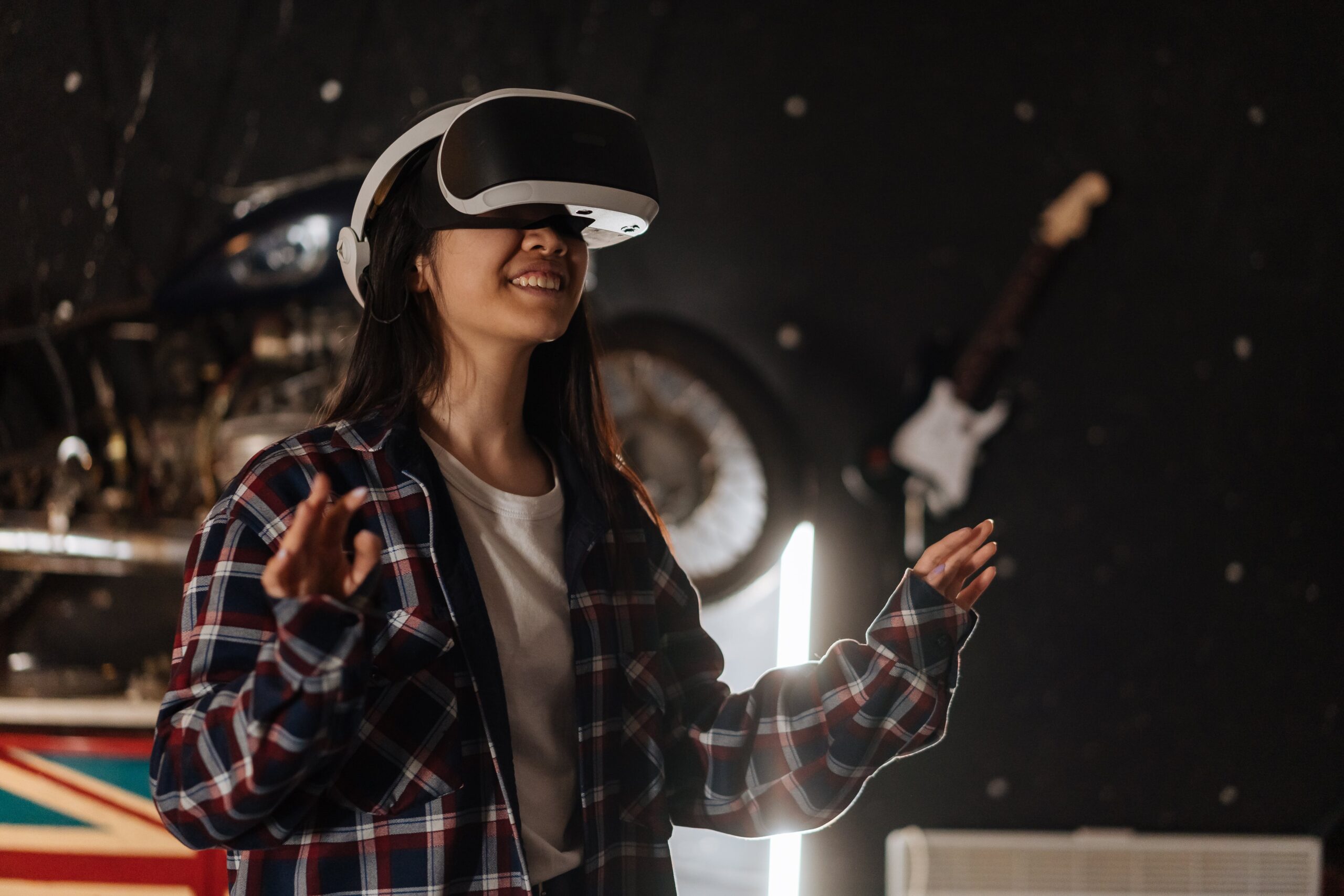
Potential benefit of applying extended reality solutions to surgical science is enhanced accuracy and precision during surgery. This can be achieved through:
- Improved pre-operative planning: XR can provide surgeons with detailed 3D visualizations of the patient’s anatomy, allowing them to plan procedures more meticulously and anticipate potential challenges.
- Real-time guidance during surgery: AR overlays can project vital information and 3D models directly onto the surgical field, guiding surgeons’ hands and minimizing the risk of errors.
- Enhanced training: VR simulations can immerse surgeons in realistic scenarios, allowing them to practice complex procedures and refine their technique in a safe, controlled environment.
These factors combined can lead to shorter surgery times, fewer complications, and ultimately, better outcomes for patients.
Extended Reality in Healthcare
Extended Reality (XR) in healthcare encompasses technologies that blend the real and virtual worlds, offering immersive experiences for various applications. This includes:
- Augmented Reality (AR): Overlays digital information onto the real world, like surgeons seeing patient data projected onto their field of view.
- Virtual Reality (VR): Creates fully immersive simulations, like surgeons practicing complex procedures in virtual environments.
- Mixed Reality (MR): Combines aspects of AR and VR, allowing for both real and virtual elements to interact seamlessly.
In healthcare, XR brings enhanced visualization, improved training, and powerful collaboration tools to various fields, from surgery and rehabilitation to education and patient care.
VR simulations offer several key benefits for training across various surgical specialties, particularly those involving minimally invasive procedures like laparoscopy:
1. Enhanced Skills & Technique: Repetitive practice allows surgeons to hone their hand-eye coordination, instrument manipulation, and procedural steps in a safe, virtual environment.
2. Improved Spatial Awareness: Immersive 3D simulations provide a deeper understanding of complex anatomy and spatial relationships within the body, compared to traditional 2D approaches.
3. Confidence & Decision-Making: Experiencing different scenarios and potential complications virtually helps surgeons anticipate real-world challenges and make informed decisions with greater confidence.
4. Minimally Invasive Expertise: VR specifically replicates minimally invasive procedures, allowing surgeons to perfect instrument control and develop essential skills for operating through small incisions.
5. Specialty-Specific Training: VR modules can be tailored to various specialties, covering common procedures, rare cases, and even practicing on specific anatomical variations.
Examples:
- Laparoscopic surgeons can practice suturing, knot tying, and delicate tissue manipulation in VR simulations of gallbladder removals or hernia repairs.
- Neurosurgeons can rehearse intricate brain tumor resections or visualize deep-seated structures within the skull before entering the OR.
- Orthopedic surgeons can virtually plan and practice joint replacements, ensuring precise implant placement and minimizing risks.
Overall, VR simulations offer a unique and valuable training tool for various surgical specialties, fostering improved skills, spatial awareness, confidence, and ultimately, better patient outcomes.
AR overlays hold immense potential in the OR, several challenges currently hinder their widespread implementation:
Cost: High-end AR headsets and software can be expensive, making them a significant investment for hospitals and individual surgeons.
Integration: Seamless integration with existing medical equipment and hospital IT systems is crucial for smooth workflow and data sharing. Current solutions might require complex adjustments or adaptations.
User Acceptance: Surgeons might be hesitant to adopt new technology due to concerns about learning curves, potential distractions, and the reliability of overlays in critical situations.
Other Challenges:
- Latency: Delays in information processing and overlay display can hinder real-time decision-making.
- Ergonomics and comfort: Wearing headsets for extended periods can lead to fatigue and discomfort.
- Data privacy and security: Ensuring patient data safety and privacy while using AR technology requires robust security measures.
Despite these challenges, ongoing research and development are addressing these concerns. As technology matures and costs decrease, AR overlays have the potential to become a valuable tool for surgeons, ultimately improving patient care and outcomes.
XR’s Impact on Surgical Education and Training:
Surgeons:
- Enhanced realism: VR simulations provide immersive practice, replicating real-world scenarios and complexities.
- Improved skill development: Surgeons can refine techniques and decision-making through repetitive, risk-free practice.
- Increased confidence: Familiarity with procedures before real-world application boosts confidence and performance.
- Accessibility: Standardized VR training can be shared globally, improving knowledge and skills of surgeons everywhere.
Medical Students:
- Interactive learning: 3D visualizations and AR overlays make anatomy more engaging and easier to understand.
- Enhanced spatial awareness: Students can explore and manipulate virtual bodies, gaining deeper anatomical insights.
- Improved knowledge retention: Immersive learning fosters better understanding and memory compared to traditional methods.
- Democratized access: XR programs can provide consistent, high-quality learning regardless of location or resources.
Ethical Considerations of XR in Surgical Training:
Data Privacy:
- Patient data: Ensuring patient privacy and security while using AR overlays during training or real-time surgery requires robust safeguards and ethical guidelines.
- Simulation data: Data collected from VR simulations raises questions about ownership, anonymization, and potential misuse of information about trainees’ performance.
Bias in Simulations:
- Algorithmic bias: Simulations developed with biased data can perpetuate prejudices in surgical decision-making, impacting patient care.
- Representation: Lack of diverse patient models in simulations can limit trainees’ exposure to different anatomical variations and potentially lead to biased approaches.
Other Considerations:
- Accessibility: Ensuring equitable access to XR training for all trainees, regardless of socioeconomic background or location, is crucial.
- Overreliance on technology: Overdependence on XR could diminish traditional surgical skills and critical thinking abilities.
- Psychological impact: Potential for anxiety or stress in trainees due to immersive simulations and pressure to perform in virtual environments.
XR in Action: Real-World Examples in Surgical Training
VR for Complex Procedures:
- Johns Hopkins Medicine: VR simulations for minimally invasive cardiac surgery, allowing residents to practice valve replacements and other complex procedures in a risk-free environment.
- Mayo Clinic: VR training for laparoscopic colon surgery, helping residents hone their skills and improve hand-eye coordination before stepping into the OR.
AR for Enhanced Visualization:
- UCLA Health: AR overlays during live surgery, projecting patient scans and vital signs directly onto the surgical field, guiding surgeons in real-time.
- Cleveland Clinic: AR-assisted robotic surgery for prostate cancer, providing surgeons with 3D visualizations of the prostate and surrounding structures for improved precision.
Global Initiatives:
- Virtual reality Medical Simulation (VRMedSim): This international consortium develops and shares standardized VR simulations for various surgical specialties, promoting accessibility and global knowledge exchange.
- Medical Realities: This company provides immersive AR and VR training solutions for diverse surgical procedures, used by institutions worldwide.
Beyond Surgery:
- Stanford University: VR simulations for medical students to explore and manipulate 3D models of the human body, enhancing anatomical understanding.
- Emory University: AR app to visualize and interact with virtual representations of medical images, improving diagnostic skills for radiologists.
These are just a few examples, and the applications of XR in surgical training are constantly evolving. As technology matures and costs decrease, expect to see even more innovative and impactful uses of XR in the future, shaping the next generation of skilled and confident surgeons.
XR Revolutionizing Robotic Surgery: A Powerful Partnership
While robotic surgery itself has already transformed many surgical procedures, combining it with Extended Reality (XR) opens up a whole new frontier in precision, training, and potentially, accessibility. Here’s a deeper dive into the exciting combination of XR and robotic surgery:
Enhanced Pre-operative Planning:
- VR simulations: Surgeons can virtually “walk through” a patient’s anatomy using 3D models, meticulously planning incisions, instrument placement, and potential challenges. This leads to shorter surgery times and fewer complications.
- AR overlays: Merging medical scans with the patient’s real body, surgeons can visualize internal structures, vital signs, and even tumor margins before making the first incision. This improves decision-making and surgical accuracy.
Intra-operative Guidance and Precision:
- Real-time AR overlays: During surgery, surgeons can see crucial information – blood vessels, nerves, tumor margins – projected directly onto the surgical field through headsets. This provides real-time guidance and reduces the risk of errors.
- Haptic feedback: Robots can be equipped with haptic feedback systems that allow surgeons to “feel” tissue resistance and virtual boundaries, enhancing their control and minimizing tissue damage.
Revolutionizing Training and Accessibility:
- VR simulations for surgeons: Trainees can practice complex procedures in immersive, risk-free environments, mastering robotic-assisted surgery before operating on real patients.
- Remote collaboration: Specialists from different locations can collaborate in real-time, assisting robotic surgery and sharing expertise, potentially improving access to specialized care in remote areas.
Despite these challenges, the potential of XR in robotic surgery is undeniable. As technology matures and costs decrease, this dynamic pairing promises to revolutionize surgical procedures, leading to increased precision, improved patient outcomes, and potentially, democratizing access to advanced surgical care.
The future of XR in surgery brims with exciting possibilities:
Enhanced Realism: Expect even more immersive VR simulations with advanced haptics and sensory feedback, replicating real-world experiences for unparalleled training.
AI Integration: AI-powered simulations will adapt to individual skill levels, providing personalized training and real-time performance feedback.
Telepresence and Remote Surgery: XR will facilitate real-time collaboration between surgeons across vast distances, improving access to specialized care in remote areas.
Augmented Microsurgery: AR overlays will offer magnified views of microscopic structures, enabling minimally invasive surgery with unprecedented precision.
Personalized Medicine: XR will integrate patient-specific data into simulations and surgical guidance, tailoring procedures to individual needs and optimizing outcomes.
Ethical Considerations: Addressing data privacy, bias in AI algorithms, and equitable access to XR technology will remain crucial for responsible implementation.
Overall, XR is poised to reshape surgical training, enhance intraoperative accuracy, and ultimately, improve patient care in innovative and groundbreaking ways.
Conclusion
XR is no longer science fiction in the surgical theater. From hyper-realistic training simulations to real-time AR guidance, its impact is already transforming surgical practices. The future holds even more promise, with AI integration, remote collaboration, and personalized medicine pushing the boundaries of what’s possible. While ethical considerations must be addressed, XR’s potential to revolutionize surgery and improve patient outcomes is undeniable. The future of healthcare is looking increasingly immersive, precise, and accessible, thanks to the transformative power of Extended Reality.
References
General XR in Surgery:
- Journal of the American Medical Association: https://pubmed.ncbi.nlm.nih.gov/36645474/
- FutureOR – XR in Surgery: https://dl.acm.org/doi/abs/10.1145/3590837.3590898
- Business Finland – XR Technology in Surgery: https://www.businessfinland.fi/en/whats-new/blogs/2022/transition-from-reality-to-extended-reality
Benefits of XR in Surgery:
- Surgical Theater – Pioneering XR in Healthcare for Enhanced Surgical Precision: https://surgicaltheater.com/
- What Are The Benefits Of Applying Extended Reality To Surgical Science?: https://appinventiv.com/blog/mixed-reality-in-modern-surgery/
Specific Examples of XR in Surgery:
- Johns Hopkins Medicine: https://pubmed.ncbi.nlm.nih.gov/34729504/
- Mayo Clinic: https://www.mayoclinic.org/medical-professionals/cardiovascular-diseases/news/developing-augmented-and-virtual-reality-treatments/mac-20462595
- UCLA Health: https://www.hopkinsmedicine.org/news/articles/2021/02/johns-hopkins-performs-its-first-augmented-reality-surgeries-in-patients
- Cleveland Clinic: https://newsroom.clevelandclinic.org/2022/08/31/robotic-prostate-cancer-procedure-reduces-recovery-time/
XR Hardware and Software:
- VRMedSim: https://www.simxvr.com/
- Medical Realities: https://www.medicalrealities.com/
FAQs
1. What’s the potential of Extended Reality (XR) in surgery?
Think of XR as a game-changer for doctors! It overlays digital information onto the real world, offering surgeons superpowers like:
Enhanced pre-op planning: VR simulations let them virtually explore patients’ anatomy, practicing procedures and anticipating challenges before the real deal.
Real-time guidance: AR overlays project patient scans and vital signs onto the surgical field, guiding their hands with laser-like precision.
Improved training: VR lets surgeons hone their skills in immersive, risk-free environments, leading to faster learning and better outcomes.
2. How can virtual reality (VR) benefit surgery?
Imagine doctors stepping into a virtual operating room! VR offers:
Safe practice: Surgeons can refine complex procedures on virtual patients, mastering techniques without risking real lives.
Personalized training: VR adapts to individual skill levels, providing targeted practice and feedback for each surgeon.
Reduced anxiety: By familiarizing themselves with procedures beforehand, surgeons enter the OR with more confidence.
3. What advantage does extended reality offer?
XR bridges the gap between the physical and digital worlds, offering:
Enhanced visualization: Imagine seeing hidden structures and vital signs projected directly onto the patient during surgery.
Improved accuracy: XR reduces errors by providing real-time guidance and minimizing the need to switch between screens and instruments.
Increased efficiency: Faster procedures and shorter recovery times are possible thanks to XR’s enhanced planning and guidance.
4. What’s a general XR application for any business?
XR transcends surgery! Here’s one example:
Remote collaboration: Imagine engineers in different locations working on a complex design together, using AR to see and manipulate 3D models in real-time.
XR’s potential is vast, and its impact on various fields is just beginning. Stay tuned to see how this innovative technology continues to reshape healthcare, business, and beyond!







